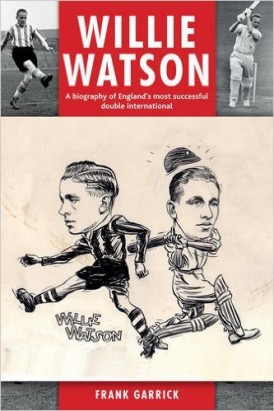Willie Watson – A Biography of England’s Most Successful Double International
Martin Chandler |Published: 2013
Pages: 240
Author: Garrick, Frank
Publisher: SportsBooks
Rating: 3 stars

Writing a good biography of the modest and unassuming is never easy, however successful they might be in the field in which they make their name. In the case of Willie Watson author Frank Garrick had to contend with a man who, on emigrating to South Africa in the mid 1960s, went so far as to re-invent himself as Bill Watson. On arrival he took up the position of Sports Manager at the Wanderers Club in Johannesburg, and tried not to let anyone know he was Willie Watson, the man who played football and cricket for England.
The sub-title of the book is an interesting assertion and one of the more thought provoking parts of Garrick’s brief is in his introduction where he seeks to justify the claim. It is also a little misleading as Garrick is only referring to footballing cricketers. In the circumstance David Frith need only recoil in horror at the imprecision of the description rather than the accolade being denied to Drewy Stoddart. The obvious competition for the Garrick edition is Charles ‘CB’ Fry. On the cricket field Fry’s First Class record is considerably better than Watson’s, and even allowing for the relative modesty of his Test record the Fry batting average still exceeds Watson’s by seven points. For Fry however there was just a single football cap, and from what I have read of CB’s ability on the football field he was some way short of the highest class. Thus Garrick’s assessment seems a fair one, although Lancastrians would champion the names of Jack Sharp and Harry Makepeace.
None of the twelve English double internationals has exceeded Watson and Fry’s combined total of 27 caps (23 for cricket and 4 football in Watson’s case) but, realistically, no one would describe Watson as a great player at either of his sports although had he not, as a result of World War Two, had to wait until he was 26 to begin his professional careers then maybe he could have achieved more. As a cricketer Watson batted in the top order for Yorkshire until 1957, and for Leicestershire for a further five summers. His football career was rather shorter, but at his peak he was a Sunderland player in the old First Division in an era when the Wearside club’s resources were such that they were known as ‘The Bank of England Club’ and they were a power in the land. He was what used to be called an inside forward.
Garrick’s book is the traditional chronological journey through his subject’s life, and clearly well researched by a writer who seems to be rather more of a football man than a cricket one. Nonetheless the account of Watson’s cricket career is a thorough and accurate one even if it is a little uninspiring. That said it is not Garrick’s fault Watson’s one major contribution to cricket history is very well known, his famous rearguard action with Trevor Bailey at Lord’s in 1953. That famous day apart Watson rarely hit the headlines on the back pages of the newspapers, let alone the front, and even seems to have managed to leave Yorkshire without any drama.
As a cricket enthusiast, who also has an interest in football, the most enjoyable parts of the book for me were the chapters on the winter game, doubtless because I knew very little about the subject beforehand. In particular I hadn’t realised that as well as his playing career Watson had also been a manager. For that he chose the sort of tough assignments that couldn’t have been further from what he had been used to with Sunderland, at Halifax Town twice, and Bradford City. The chapter dealing with the winters immediately before he emigrated was certainly the highlight of the book for this reviewer.
Part of the reason it has taken me some time to review Willie Watson – A Biography of England’s Most Successful Double International is a fairly negative review I read at the time of publication. Having now read the book I can see where that reviewer was coming from, although I do believe his judgment was unnecessarily harsh. A biography of Willie Watson must have always been intended to be rather more in the labour of love category than that of potential bestseller. Despite that Garrick has made a very good job of telling Watson’s story. One legitimate criticism is the fact that the book, which is otherwise nicely produced, lacks any photographs. I cannot readily recall ever having seen such a biography before, so it is an unusual omission. Less unusual in a biography is the lack of an index, but a decent one of those is present, but a let down is the statistical section. There are some figures but so rudimentary as to be of little use to Garrick’s reader, who will do well to keep Watson’s entry on CricketArchive open.
In conclusion Willie Watson – A Biography of England’s Most Successful Double International is certainly not required reading but, whilst accepting in the 21st century there won’t be too many students of Watson’s career , for anyone interested in his life and times it is certainly worth a read despite its occasional shortcomings.






Leave a comment